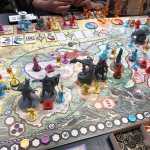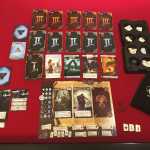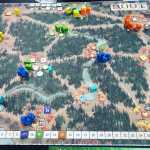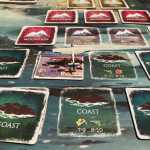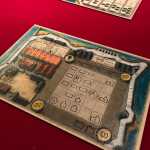Review: Mountains of Madness

"Fly the plane north! Not east! Fly the plane north!"
"Are you sure?"
"YES IM SURE FLY THE PLANE NORTH AHHHHHH"
----
And so goes a normal game of Mountains of Madness. I want to start off this review with one, very clear statement: this is not a heavy survival game. This is a party game.

This is a really important thing to note, because at first glance of this game you are immediately taken back to familiar games like Eldritch Horror or Mythos Tales. The game pits you and your crew trying to get up a mountain to the top, collecting relics along the way, trying to not get injured, and also, mind you, trying to not go completely bonkers doing it. You progress up the mountain by simple 1-step movement, and do "skill tests" in the same vein as the other Lovecraftian games - get a certain number of points of a type to pass. Instead of die, you have equipment cards that have varying numbers (2-6, and some 10s you can get along the way) that you and your team must put together to get a specific number. Pass and you get a semi-good thing. Fail and really bad stuff happens.
Like those games, really bad stuff will happen. A lot. You don't end this game buffed and invulnerable. Like those games, you end it flying a burning plane off the mountain while half your team is trying to eat the cockpit chairs, and the other half is leaking more blood than the plane is leaking fuel.
If you're getting a picture of this game being a madhouse, great! Because that's precisely what it is. But that's basically where the comparisons with Eldritch-style games end. The enjoyment of this game isn't in completing the skill-test puzzle, or the glee of winning while barely surviving - it's the insane, hilarious moments you get while playing it.
Let's dig in!
Gameplay
The basic premise of this cooperative game is pretty simple: move, do a test, everyone pick cards to play, resolve results. Turns are broken up into five phases: Movement, Encounter, Resolution, Draw, and an optional Rest phase. However, during each of these phases different forms of constraints and actions can be taken.

Movement is fairly simple: pick a place to go on the board, which is obviously mountain-shaped, and increasingly more difficult as you get near the top. You don't have to always go up - you can go back down or sideways, which you will likely want to do, because to win this game you need to collect a sizeable number of relics. Specifically, more than the collective injuries as a team you will collect along the way.
The Encounter Phase is also similarly straightforward, but is the most manic phase of the game. The leader will flip over the tile, which will show 2-3 "tests" the team has to make. There are four types, and you will have cards in your hand that match those types. Your team has 30 seconds to collectively put cards onto the sled tile that total up to the numbers on the tile. The tile numbers will start as a range (say, 10-12), but as you get higher will end up as just single number targets.
Now what makes this part crazy is you cannot describe to your teammates anything about the value of the cards you're playing. You can't say the number. You can say things like "I think I can get tools", but nothing more specific in that. Also, if someone puts down cards onto the sled, no one can talk anymore. Oh, and by the way, 30 seconds is a nuts amount of time to do this. You will, inevitably, all be in a screaming fit of panic to match the total with everyone yelling out "I can get green, I mean tools! I'm most of the way to boxes! HOW MUCH IS MOST AHHHH!"
After the time expires (or the team is done, whichever first), the leader counts the totals and finds out if the team passed any of the challenges. Pass at least one and the team gets the reward on the tile. The rewards vary from an ability to peek at future tiles, getting leadership tokens back, healing injuries, getting those elusive relics, or getting "arcane equipment" cards which have a value of 10.
If the team fails any of the challenges, the leader chooses one of two choices - either give a player a madness card (which you start at level one, and as you get another you "level up" your madness, ha ha ha), or roll the penalty die. The die either makes you discard equipment cards from the deck - the only way to get cards back into the deck is rest, which permanently loses you a leadership token - get 2 injury cards, or straight discard leadership tokens.
Finally people draw back up to their hand limit. This has to surprisingly be planned for, because if you don't have cards in the deck, you don't shuffle the discard pile back in. That only happens in the next optional phase, the rest phase. So you have to plan ahead for this - rest too much and you burn through your leadership tokens; rest too few times and you'll not have enough cards to pass tests.
There's Always a Lack of Leadership
During each phase, the leader of the team - which rotates each turn - can spend "leadership tokens" to affect the game in different ways. There are only 6 of these tokens, and you'll slowly start to lose them as the game progresses. Using one puts it in discard, and you have to "rest" at the end of the turn to get them back (or complete certain tests), so you'll want to use these sparingly.

What more could anyone want?!
What you can do here differs per phase. In movement, you can spend to ignore a player's madness cards for the turn; spend one during the encounter phase to get an extremely valuable 30 seconds added to your clock (we've had to do this a lot in my playthroughs), re-roll the penalty die during resolution, or increase your hand size limit by 1 for the next round when drawing.
You shouldn't forget about spending these - they're vital to your success, especially as you go higher up the mountain. That said, I found us spending these more out of necessity than strategy, because the encounter phase especially is so chaotic, and you really need more cards for higher levels.
I like the mechanic of these here - giving a bit of variance and control to what could just be a staid, high-RNG mechanic with hand management. It also helps when you realize halfway through the play that this game is evil and starts changing the colors of the types of cards as you go up the mountain, to illustrate the madness you are accumulating. You check against the type, not the color, but earlier you're likely talking about them with regards to color, which will completely mess with your head later. It's a pretty great detail by the designers.
Ma-ma-ma-ma-ma-mad-mad-mad
Enter the best part of this game, and it's real bread and butter. Each player will accumulate madness cards throughout the game, which dramatically affect their play. From not allowing them to talk unless spoken to, having to answer "are you sure?" to each question asked of them, to having to hold your cards above your head at all times, the game throws these cards at you to just make it so damn funny. Mountains of Madness would be a boring trek without these, and if you're focused on playing these games as a min-max hand management game, you're missing out.
Each player gets increasing levels of madness - and if everyone is at level 3 and has to draw another, you lose - and you're not allowed to tell people about your madness. This makes it especially funny when one player is completely silent and not responding to anything you're saying, until you say in jest looking at his character card, "This Danforth guy is a jerk", and he yells out "FINALLY I CAN SPEAK YOU FOOLS!". It's these moments that make this game a load of fun.
You have to draw madness for failures, when getting a relic, and in other various circumstances, so you'll definitely get mad as you progress. And because no one else knows how you're mad, and you have no clue what they're mad with, it all kind of just cascades into chaos by the end of the game. The narrative feel of it really resonates and you can definitely get into it.
There are a few problems with it, though. One drawback is the madness really seem highly variable on how badly they will affect your game. There's a huge RNG factor to them, so you might just pick up a madness that has virtually no effect on your game, or another that is horribly crippling. It just depends. Also, madness only really applies during the encounter phase, which seems like a miss by the designers. You can't talk about your insanity outside of that phase - in fact, the game tells you to act like it never happened - but the very limited effect diminishes its hilarity. I'd definitely house rule this and have madness apply at all times to increase the fun factor for sure.
Thoughts
I really liked Mountains of Madness. I'm kind of big into heavier games that still manage to bring in a social element, and this game does that in strides. The key reaction difference I've seen in this game totally depends on your expectations going in. This is not an Arkham Horror: LCG variant, where you are just trying to survive a thick narrative, or Eldritch Horror where you're desperately working against forces arraying against you. If you have the expectation that this is a medium-weight, slightly-luck-driven game with a huge role-playing element to it, you'll have a blast. If your table does the madness cards with lackluster effort, the game will suck for you. If you're going to play MoM, go hard on the madness, and really have fun with it. Consider making madness permanent. It really enhances the experience.

LOOK AT IT!
There are a couple of other flaws - the board gets a bit stale after a few plays, as it's basically the same setup with just slight difference in the order of the tests you encounter. The character sheets seem like an afterthought as they have no real effect on the game - I would have loved some sort of "fatal flaw" mechanic to each character that amplified their insanity throughout the game. The plot is really light, and this game really could have used more difficulty scaling (the only scale is to combine all madness rather than replacing, which seems like a cheap out). By your third or fourth play as a team you'll have the game mechanics fairly down pat to win every time.
You can house rule this all away, of course, but you shouldn't have to. Daviau definitely could have run this through a few more paces to fine-tune some of the variance mechanics.
But, I'd say that the pros definitely outweigh the cons here. The price is great - $30-40 - and you can do a full playthrough in under an hour, which makes it a great start game for an evening, or a easy happy hour game with friends. It's got enough skill/heaviness to please more hardcore gamers, while being accessible to newer gamers or those that prefer lighter fare. The art and the components are top-notch - you get a nicely wooden-framed hourglass for goodness sakes - and it all fits really nicely into the theme.
Plus, if you go into it right, you'll walk away with some pretty memorable experiences. I for one will always call one of my tablemates "Danforth" now, and I have this little gem of a game to thank for it.
Pros
- Fun survival game with great replay value
- Madness cards are hilarious
- Group matching challenges are a madhouse and wonderful
- Wonderfully made pieces/art
- Well priced
Cons
- Singular map structure can get old
- Not much plot/story consistency
- Character diversity would have been nice
- True difficulty scale needed
great
Board game reviews and news from Austin, Texas. We provide no-nonsense reviews about all kinds of games. With flair.

